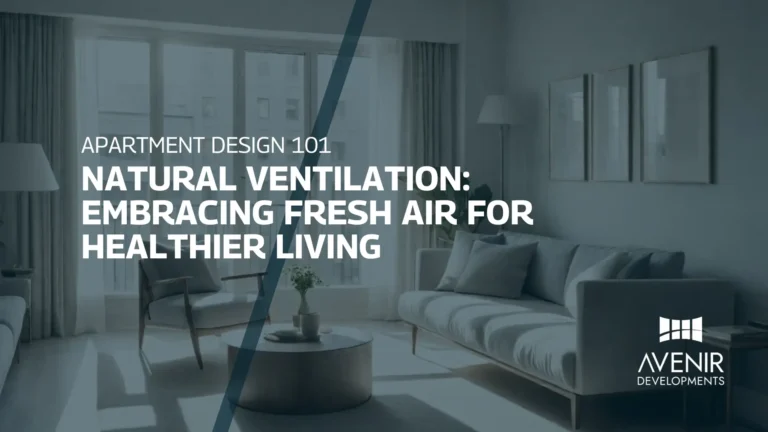I still vividly remember the suffocating feeling of stepping into my first tiny apartment in Islamabad. The air was stagnant, heavy, and it felt like the walls were closing in. It wasn’t just the small size; the lack of fresh air was stifling. I knew I couldn’t live like that, especially with my background in architecture and design, where air quality and natural ventilation are paramount.
It was a turning point. I dove into researching natural ventilation, experimenting with my own apartment, and learning from experts around the world during my travels. The transformation was incredible. Not only did my apartment feel more spacious and inviting, but my health and well-being improved dramatically.
If you’re an apartment dweller struggling with stuffy air, poor ventilation, or simply want to create a healthier living environment, this guide is for you. We’ll explore the power of natural ventilation, how it works, and practical steps you can take to improve air quality in your own apartment. Trust me, the results are worth it.
Let’s open up those windows and doors, and let the fresh air flow!
Understanding Natural Ventilation: A Breath of Fresh Air
Natural ventilation, in its simplest form, is the process of using natural forces like wind and temperature differences to circulate fresh air into and stale air out of a building. It’s the age-old practice of opening windows and doors to let air flow naturally, without relying on mechanical systems.
Historical Context and Evolution
From ancient civilizations to modern architecture, natural ventilation has been an integral part of building design for millennia. In the scorching heat of Mohenjo-daro in Pakistan, wind catchers were used to funnel cool breezes into homes, while in traditional courtyard houses throughout the Middle East, ventilation was optimized through carefully placed windows and courtyards.
As technology advanced, we saw the rise of mechanical ventilation systems, which offered greater control over airflow and temperature. While these systems have their place, they often come at the cost of energy consumption and can create an artificial environment that lacks the freshness and vitality of natural air.
In recent years, there’s been a resurgence of interest in natural ventilation, driven by a growing awareness of its benefits for health, well-being, and sustainability. Architects and designers are incorporating natural ventilation strategies into modern buildings, from residential apartments to commercial spaces. In Pakistan, we’re seeing a growing trend towards sustainable architecture, with projects like the Zero Carbon Building in Islamabad showcasing innovative natural ventilation techniques.

The Importance of Natural Ventilation in Apartments
In the context of apartments, natural ventilation plays a crucial role in maintaining a healthy and comfortable living environment. Here’s why it’s so important:
- Improved Air Quality: Natural ventilation helps to remove indoor air pollutants like dust, allergens, volatile organic compounds (VOCs), and even viruses and bacteria. Fresh air dilutes these pollutants and replenishes oxygen levels, creating a healthier indoor environment. A study by the Harvard T.H. Chan School of Public Health found that improved ventilation in offices led to significant improvements in cognitive function and reduced symptoms of sick building syndrome.
- Thermal Comfort: Natural ventilation can help to regulate indoor temperatures, reducing the need for air conditioning and heating. By harnessing natural airflow and temperature differences, you can create a comfortable living space that feels naturally cool in the summer and warm in the winter. In a hot climate like Islamabad’s, cross-ventilation through strategically placed windows and doors can significantly improve thermal comfort.
- Energy Efficiency: By reducing the reliance on mechanical ventilation systems, natural ventilation can help to lower energy consumption and reduce your carbon footprint. This is not only beneficial for the environment but can also lead to significant cost savings on your energy bills.
- Health and Well-being: Studies have shown that exposure to fresh air and natural light can have a positive impact on our physical and mental health. Natural ventilation can help to reduce stress, improve sleep quality, boost mood, and even enhance cognitive function. In a recent survey conducted in Lahore, residents of apartments with good natural ventilation reported higher levels of satisfaction with their living environment and overall well-being.
- Sustainability: Natural ventilation is a key component of sustainable building design. By utilizing natural resources like wind and temperature differences, we can reduce our reliance on fossil fuels and create healthier, more eco-friendly living spaces. The Pakistan Green Building Council (PGBC) has developed a rating system to promote sustainable building practices, and natural ventilation is a key criterion in this system.
Natural Ventilation in Pakistan and Beyond: Latest Trends and Developments
In Pakistan, the concept of natural ventilation is gaining traction as architects, builders, and homeowners alike recognize its benefits for health, sustainability, and cost-effectiveness. The country’s diverse climate, with scorching summers and mild winters, presents unique challenges and opportunities for natural ventilation strategies.
Recent Government Updates and News
The government of Pakistan has been actively promoting sustainable building practices, including the use of natural ventilation, through various initiatives and policies. For example, the Ministry of Climate Change launched the Pakistan Cooling Action Plan in 2021, which aims to reduce the country’s reliance on air conditioning and promote energy-efficient cooling solutions, including natural ventilation.
Additionally, the Pakistan Green Building Council (PGBC) has been instrumental in raising awareness and setting standards for sustainable building practices. Their Green Building Rating System encourages the use of natural ventilation and provides guidelines for its implementation in various building types.
Recent news reports have highlighted innovative projects that are incorporating natural ventilation in Pakistan. For instance, the Zero Carbon Building in Islamabad, designed by a team of local architects, utilizes passive cooling techniques and natural ventilation to create a comfortable and energy-efficient workspace.
Global Trends in Natural Ventilation
Natural ventilation is not just a trend in Pakistan; it’s a global movement gaining momentum as the world grapples with the challenges of climate change and resource scarcity. Architects and designers around the world are exploring innovative ways to harness natural forces to create healthier, more sustainable buildings.
In Europe, passive house standards have become increasingly popular, emphasizing airtight construction and heat recovery ventilation systems to minimize energy consumption. However, natural ventilation is still recognized as an essential component of healthy indoor environments, and many passive house designs incorporate strategies for natural airflow and cross-ventilation.
In Asia, traditional building practices that emphasize natural ventilation are being reinterpreted and adapted to modern contexts. For example, in Singapore, architects are incorporating vertical greenery and wind scoops into high-rise buildings to enhance natural airflow and reduce the need for air conditioning.
Analysis of Current Trends
The growing interest in natural ventilation in Pakistan and around the world is driven by several factors:
- Increased awareness of health and environmental impacts: People are becoming more aware of the negative health effects of poor indoor air quality and the environmental impact of energy-intensive cooling systems. Natural ventilation offers a healthier and more sustainable alternative.
- Rising energy costs: As energy costs continue to rise, homeowners and businesses are looking for ways to reduce their energy consumption. Natural ventilation can significantly lower cooling and heating costs.
- Technological advancements: New technologies and design tools are making it easier to incorporate natural ventilation into modern buildings. Computational fluid dynamics (CFD) modeling, for example, allows architects to simulate airflow patterns and optimize ventilation strategies.
- Government incentives and regulations: Governments around the world are implementing policies to promote sustainable building practices, including the use of natural ventilation. In Pakistan, the PGBC’s rating system provides incentives for builders to adopt green building practices.
These trends suggest that natural ventilation is not just a passing fad but a fundamental shift in the way we think about building design and indoor environments.
Common Questions about Natural Ventilation in Apartments
Natural ventilation can seem simple in theory, but there are nuances to understand, especially for apartment dwellers. Here are some frequently asked questions to help you optimize airflow in your space:
How Can I Improve Air Circulation in My Apartment Naturally?
There are several ways to enhance natural ventilation in your apartment:
- Open Windows and Doors Strategically: Create a cross breeze by opening windows on opposite sides of your apartment. If possible, open windows at different heights to take advantage of the stack effect, where warm air rises and draws in cooler air from below.
- Utilize Ceiling Fans: Ceiling fans can help to circulate air and create a cooling effect. In the summer, set your fans to rotate counterclockwise to push air down. In the winter, reverse the direction to pull warm air up from the ceiling.
- Install Window Screens: Window screens allow you to keep windows open without worrying about insects or debris.
- Clear Obstructions: Ensure that furniture and other objects don’t block airflow from windows or vents.
- Use Window Treatments Wisely: Light-colored curtains or blinds can reflect sunlight and reduce heat gain, while heavy drapes can impede airflow.
What are the Best Ways to Naturally Ventilate My Apartment?
The best ventilation strategy will depend on the layout of your apartment, the climate, and the time of day. However, here are some general tips:
- Morning and Evening Ventilation: Open windows and doors in the morning and evening when temperatures are cooler and air quality is typically better.
- Utilize Wind Direction: If your apartment has windows facing different directions, open windows on the side where the wind is blowing to maximize airflow.
- Consider the Stack Effect: If your apartment has multiple floors, open windows on both levels to create a natural chimney effect that draws air up and out of the space.
How Can I Reduce Humidity in My Apartment Using Natural Ventilation?
Natural ventilation is an effective way to reduce humidity in your apartment. By increasing airflow, you can help to remove excess moisture and prevent the growth of mold and mildew.
Here are some tips:
- Ventilate After Showering or Cooking: Open windows and doors after showering or cooking to release steam and moisture.
- Use Exhaust Fans: Kitchen and bathroom exhaust fans can help to remove moisture from these areas.
- Dry Clothes Outdoors: If possible, hang your laundry outside to dry instead of using a dryer.
Air Purifier Alternatives
While air purifiers can be helpful in removing certain pollutants, natural ventilation is often a more effective and sustainable solution for improving overall air quality in your apartment. Here are some air purifier alternatives:
- Houseplants: Certain houseplants, like spider plants, snake plants, and peace lilies, can help to purify the air by absorbing VOCs and other pollutants.
- Activated Charcoal: Activated charcoal filters can be used to absorb odors and pollutants.
- Beeswax Candles: Beeswax candles release negative ions, which can help to neutralize pollutants in the air.
Best Practices for Natural Apartment Ventilation in Different Seasons
The optimal ventilation strategy for your apartment will vary depending on the season:
- Summer: Maximize cross-ventilation by opening windows on opposite sides of your apartment. Use ceiling fans to create a cooling effect. Close windows and blinds during the hottest part of the day to reduce heat gain.
- Winter: Open windows for short periods to allow fresh air to circulate, but be mindful of heat loss. Use weatherstripping and caulking to seal gaps around windows and doors.
- Spring and Fall: Take advantage of mild temperatures to open windows and doors for longer periods.
Expert Tips for Optimizing Natural Ventilation in Your Apartment
As an architect and interior designer with experience in Pakistan and abroad, I’ve seen firsthand how a well-designed apartment can harness the power of natural ventilation to create a healthy and comfortable living environment. Here are some expert tips based on my experience:
- Window Placement and Design: When choosing an apartment or renovating your existing one, pay close attention to window placement. Ideally, you want windows on opposite sides of your apartment to facilitate cross-ventilation. Consider the direction of prevailing winds in your area and orient your windows accordingly. In Islamabad, for example, south-facing windows can capture winter sunlight for passive heating, while north-facing windows can provide cooling breezes in the summer.
- Ventilation Strategies for Different Room Types: Each room in your apartment has different ventilation needs. In the kitchen, prioritize exhaust fans to remove cooking fumes and moisture. In the bathroom, ensure adequate ventilation to prevent mold growth. In bedrooms, cross-ventilation and access to fresh air are essential for a good night’s sleep.
- Landscaping for Enhanced Airflow: If you have a balcony or terrace, consider incorporating plants that can help to improve air quality and create a more pleasant environment. Vines and climbing plants can provide shade and reduce heat gain, while fragrant herbs and flowers can add a natural air freshener to your living space.
- Seasonal Adjustments: Adapt your ventilation strategies to the changing seasons. In the summer, maximize airflow by opening windows and doors during cooler hours. In the winter, be mindful of heat loss and only open windows for short periods to refresh the air.
- Maintenance and Cleaning: Regularly clean your windows, vents, and fans to ensure optimal airflow. Dust and debris can accumulate and impede ventilation, so make cleaning a regular part of your apartment maintenance routine.
- Airflow Monitoring: Consider using an airflow monitor to track the air quality in your apartment. These devices can measure factors like carbon dioxide levels, humidity, and temperature, giving you valuable insights into your indoor environment.
- Professional Consultation: If you’re unsure about the best way to improve natural ventilation in your apartment, consult with an architect or interior designer. They can assess your space, recommend specific strategies, and even help you design a renovation plan to optimize airflow.
Remember, natural ventilation is not a one-size-fits-all solution. It requires a thoughtful approach that considers the unique characteristics of your apartment, the climate, and your lifestyle. By implementing these expert tips, you can create a healthier, more comfortable, and more sustainable living environment.
Embrace Natural Ventilation for a Healthier Apartment Living
In our pursuit of modern comforts, we often overlook the simple yet profound impact of natural ventilation. Fresh air isn’t just a luxury; it’s essential for our health, well-being, and the sustainability of our homes. Whether you’re in a bustling city like Islamabad or a serene village in the countryside, the principles of natural ventilation remain the same: harness the power of nature to create a healthier, more comfortable living space.
By implementing the strategies and tips outlined in this guide, you can transform your apartment into a haven of fresh air. You’ll not only improve your indoor air quality but also reduce your energy consumption, lower your bills, and enhance your overall well-being. It’s a win-win situation for you and the environment.
So, open up those windows, let the breeze flow through your home, and breathe easy knowing you’re taking a step towards a healthier, more sustainable lifestyle. After all, as we say in Pakistan, “Hawa Badlo, Zindagi Badlo” – change the air, change your life.
If you’re looking to optimize natural ventilation in your apartment or home, don’t hesitate to reach out to Avenir Developments. Our team of experienced architects and interior designers can help you assess your space, recommend personalized solutions, and create a design that prioritizes your health, comfort, and sustainability goals. Contact us today on WhatsApp or Call +923001101103 for a free consultation and let us help you breathe new life into your living space.






